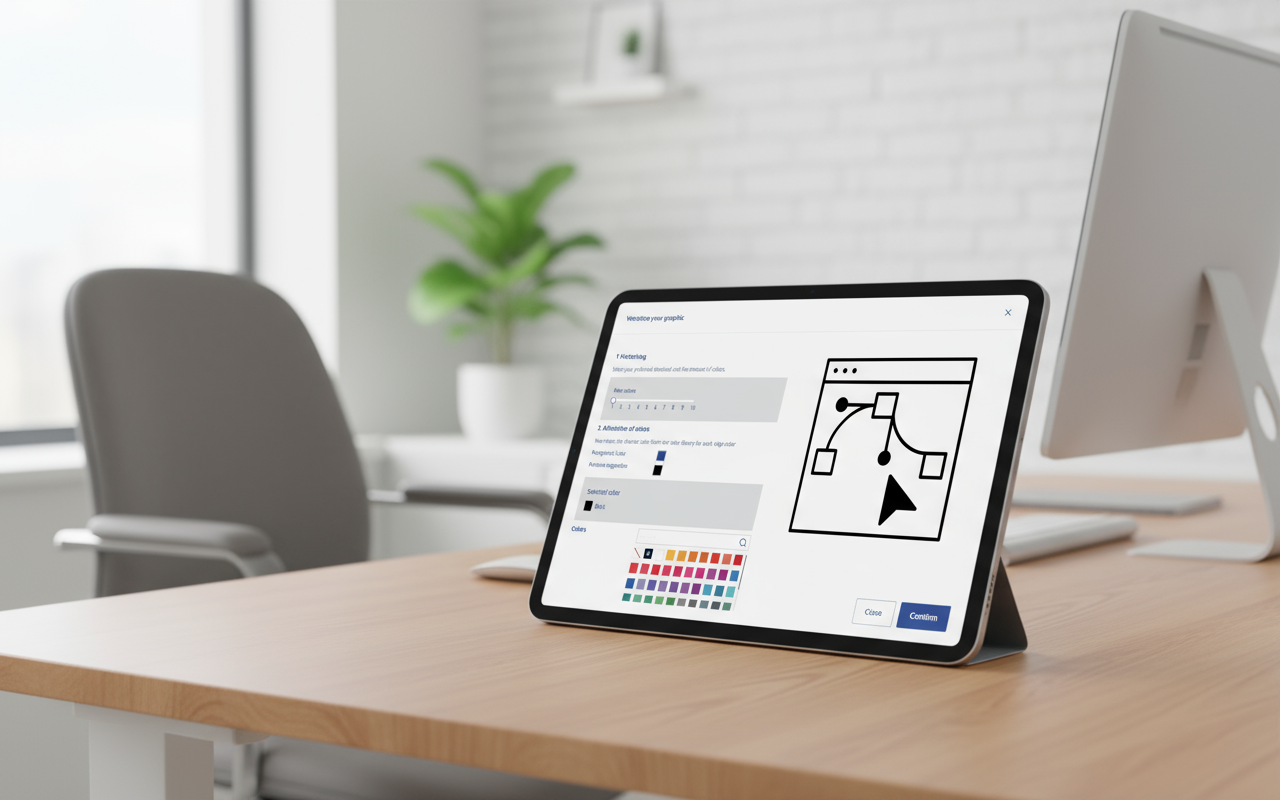Variable Data Printing – Personalization Meets Automation

printQ’s Variable Data Printing (VDP) feature empowers print providers and businesses to produce fully personalized print materials at scale — from letters and labels to packaging and promotional mailings. Built on Adobe Magento and seamlessly integrated into printQ’s automation workflow, VDP transforms mass printing into individualized communication.
Variable Data Printing in printQ: Turning Mass Production into Personal Communication
In today’s digital era, personalization is no longer optional — it’s the key to engagement. Whether you’re running a nationwide direct-mail campaign or producing customized name badges for a corporate event, personalization drives response rates and customer loyalty.
This is where printQ’s Variable Data Printing (VDP) feature steps in. Designed for print service providers, agencies, and enterprise clients, VDP allows you to merge creative design with individual data — automatically, accurately, and at scale.
With printQ, you can produce thousands of unique print items — each with different names, images, QR codes, or messages — all generated through one seamless workflow.
What Is Variable Data Printing (VDP)?
Variable Data Printing refers to the process of automatically inserting personalized information — such as names, serial numbers, addresses, or images — into a design template.
Instead of creating each layout manually, printQ users define variable fields once and then connect them to structured data sources like CSV files, databases, or CRM systems.
During production, printQ automatically merges the data with the template, creating a complete set of personalized print files ready for output — without any manual repetition.
Example use cases:
- Direct-mail letters with individual greetings
- Event badges with unique QR codes
- Coupons with personal discount codes
- Product labels with serialized barcodes
- Gift cards featuring individual names or photos
Each version looks tailor-made, yet it’s produced as part of a fully automated workflow.
How printQ Makes VDP Effortless
printQ’s Variable Data Printing module combines intuitive usability, automation depth, and integration flexibility — making it a powerful solution for every modern print business.
Let’s break down how it works.
Data-Driven Design in the Browser
VDP starts directly inside the printQ Online Editor, a browser-based WYSIWYG environment. Users can design templates with variable placeholders — for example, <First Name>, <Promo Code>, or <Branch Address>.
Each placeholder is linked to a data column. Once the dataset is uploaded, printQ instantly previews how each personalized version will appear — in both 2D and 3D.
No external software or plug-ins are needed. Designers and customers alike can manage the process entirely online, from any device.
.webp)
Seamless Data Import
printQ supports CSV, XML, Excel, and JSON file formats for importing data. The system automatically recognizes column headers and assigns them to the defined variable fields.
For enterprise clients, data can also flow directly from ERP, MIS, CRM, or PIM systems via printQ’s open REST/SOAP APIs.
That means no manual uploads, no copy-paste errors — just direct data synchronization between your internal systems and printQ.
Automated Output Generation
Once the dataset and template are connected, printQ automatically generates individual, print-ready PDFs — each with the correct personalized data, cutting marks, and color profiles.
The Preflight system ensures every record meets print specifications (e.g., CMYK conversion, image resolution, and font embedding) before production begins.
In other words: no manual checks, no misprints, no rework.
Full Workflow Automation
VDP doesn’t end at the design stage — it’s fully integrated into printQ’s end-to-end automation pipeline.
From order intake through Preflight, data merge, PDF generation, and job ticket creation, every step flows automatically into production.
This enables a “lights-out” printing environment — where recurring, data-driven print jobs run without operator intervention.
For print shops, that means faster turnaround, higher throughput, and lower operating costs.
Real-Time Visualization and Quality Assurance
Thanks to real-time 2D/3D previews, printQ users can visually confirm that all personalized elements appear correctly before submitting a job.
This immediate feedback eliminates costly proofing rounds and helps end-customers trust the process — especially in high-volume campaigns.
Combined with printQ’s vectorization and embellishment simulation, even complex visual variations (like foil or emboss effects) can be reviewed accurately on screen.

The Benefits of Variable Data Printing in printQ
Variable Data Printing unlocks measurable value for both printers and enterprise clients. Here’s why this feature has become a core differentiator in printQ’s ecosystem.
Mass Customization at Scale
With printQ’s VDP, you can produce one-to-one marketing materials at the speed and efficiency of mass production.
What once took hours of manual layout editing can now be done in seconds — simply by importing a spreadsheet.
This ability to combine mass scale with individual relevance is what makes Mass Customization such a powerful tool in modern print commerce.
Consistent Brand Identity Across Personalization
For corporate clients managing multiple branches or franchise partners, brand consistency is essential.
printQ’s VDP enforces locked design elements — such as logos, fonts, and colors — while allowing local customization of text or contact information.
This ensures every personalized output remains on-brand, compliant, and professional, even when produced by hundreds of local users.
Reduced Errors and Manual Work
Traditional personalization workflows rely heavily on manual file edits. printQ eliminates that risk by combining automated data mapping with integrated Preflight validation.
No more typos in names or missing barcodes — every field is verified before printing starts. The result is error-free, production-ready output every time.
Seamless Integration with Existing Systems
Because printQ is built on Adobe Magento and follows a headless API-first architecture, VDP connects effortlessly with other systems:
- ERP/MIS for order management
- CRM for personalized customer data
- PIM/DAM for media assets
- Shopware or Shopify for eCommerce integrations
This flexibility means that Variable Data Printing can become a natural extension of your digital print workflow, not a separate tool.
End-to-End Automation
Automation is in printQ’s DNA. When combined with VDP, the system achieves true end-to-end efficiency:
- Order received through a storefront (B2C or B2B)
- Template selection and variable mapping
- Data import and validation
- Automatic generation of individual print files
- Direct production handoff via JDF or XML
Every step happens without human input — ensuring speed, accuracy, and scalability.
Real-World Applications of printQ’s VDP
For Print Service Providers
VDP enables printers to expand their offerings beyond standard jobs. By providing data-driven personalization, they attract new clients in direct marketing, events, and retail.
Routine jobs like name tags, certificates, or mail campaigns can now be automated and produced profitably — even in short runs.
With automated file generation and Preflight, operators can handle more orders with fewer resources, optimizing machine utilization.
For Agencies and Marketing Teams
Agencies can use printQ’s VDP to deliver personalized campaigns at scale for multiple clients.
For instance, a creative agency can create one campaign template, upload different customer data files for each brand, and instantly produce thousands of personalized mailers — all within one printQ installation.
This approach not only saves time but also ensures CI-compliant customization, since templates can lock brand assets while allowing controlled personalization.
For Enterprise Clients and Franchises
Large corporations, banks, insurance companies, and retail chains often struggle with decentralized print needs.
VDP within printQ solves this by enabling decentralized personalization with centralized control.
Local branches can order personalized materials (like stationery, business cards, or flyers) while the central marketing team maintains design consistency.
It’s the perfect balance between flexibility and governance.

Technical Highlights of printQ’s VDP
Scalable Data Handling
printQ can process thousands of records simultaneously, generating personalized output in parallel. The system is optimized for high-volume variable jobs, making it suitable for both digital and offset workflows.
Native PDF Engine Integration
By leveraging PDFlib technology, printQ ensures that variable data is placed precisely in the intended layout positions — with perfect typography, no text overflow, and accurate barcode rendering.
Each generated file complies with professional prepress standards, including CMYK profiles, bleed areas, and trim marks.
2D and 3D Visualization
While most Web-to-Print systems only show static previews, printQ provides real-time 3D visualization, ideal for packaging and promotional products.
Users can spin, zoom, and inspect their personalized designs from every angle before confirming the order — creating confidence and reducing waste.
Data Security and Hosting Flexibility
Since printQ can be deployed either as SaaS (Cloud) or On-Premise, sensitive customer data can remain entirely within your infrastructure if needed.
This makes it a trusted solution for corporate and government environments where data sovereignty and GDPR compliance are top priorities.
VDP as Part of the Larger printQ Ecosystem
printQ’s strength lies in its modular architecture. Variable Data Printing integrates seamlessly with other key components:
- Template Gallery: Ready-made, industry-specific layouts
- Online Editor: Real-time customization in any browser
- Preflight Automation: Automated error detection
- packQ (3D Packaging): VDP support for folding cartons and boxes
- APIs: Connect external systems effortlessly
This modularity ensures that VDP is not an isolated feature — it’s a core element of a complete, automated print workflow.
Measurable Impact – Efficiency, Profit, and Engagement
Implementing Variable Data Printing through printQ has measurable ROI across all levels of a print business.
- Time savings through automation
- Higher order volumes without additional staff
- Reduced error rates and reprints
- Increased client satisfaction due to personalization
- New revenue streams from data-driven campaigns
By turning traditional printing into a data-powered process, printQ allows print providers to evolve from service vendors to strategic marketing partners.
Future-Ready – AI Meets Variable Data Printing
CloudLab continues to expand printQ’s capabilities, introducing AI-assisted template creation and intelligent data mapping.
In upcoming releases, users will be able to generate dynamic templates automatically, detect layout inconsistencies, and predict optimal personalization patterns.
This evolution ensures that printQ’s VDP remains future-proof, ready for the next generation of smart, data-driven print automation.
Personalization at the Heart of Modern Printing
The age of static printing is over. Personalization is the new standard, and printQ’s Variable Data Printing feature is the engine that makes it scalable, secure, and effortless.
From personalized mailers to large-scale B2B portals, printQ brings together everything the print industry needs to deliver speed, accuracy, and emotional relevance.
For print providers, agencies, and enterprises, VDP is not just a feature — it’s a competitive advantage.
With printQ, Variable Data Printing becomes what it was always meant to be:
efficient, automated, and beautifully personal.





